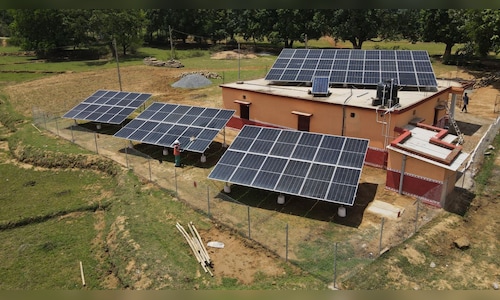Investors will have the chance to gauge the industry’s sentiment amid the spectacle of the world’s largest solar fair in Shanghai this week. The conference and exhibition commence on Tuesday and usually draw in hundreds of thousands of visitors.
The exceptional growth of the solar industry in China obscures harsh economic realities confronting equipment manufacturers. Profit margins have plummeted as intense competition compels them to sell at a loss. Increasing protectionism is restricting exports. These challenges will intensify once a policy-induced rush to install solar panels in China diminishes in the latter half of the year.
In April alone, China added approximately 45 gigawatts of solar power, more than three times the amount from the same month last year. This brings the total capacity to just a few gigawatts short of one terawatt, roughly half of the global capacity.
However, this surge was not fueled by genuine demand. Developers accelerated project completions to secure more favorable conditions before two new policies went into effect.
The first, starting in May, imposes restrictions on rooftop installations, a sector that has seen rapid growth in recent years. The second policy, effective earlier this month, removes price protections for generators, forcing them to compete in the open market during a time of abundant electricity supplies.
“Once the current surge concludes, the outlook for China’s solar industry in the latter half remains highly uncertain,” Trivium China noted last month, casting doubt on whether the rapid pace of growth can be sustained.
Equipment manufacturers may find it challenging to acknowledge these booming conditions, having built excessive capacity that diminishes their ability to benefit. Their profitability has been on a decline for the past two years. The five largest companies—JA Solar Technology Co., Jinko Solar Co., Longi Green Energy Technology Co., Tongwei Co., and Trina Solar Co.—reported a collective loss exceeding 8 billion yuan ($1.1 billion) in the first quarter.
Worse might be on the horizon as developers purchasing their panels scale back operations in the upcoming months. Citigroup Inc. anticipates a slowdown in installations to 90-95 gigawatts in the latter half, down from 155-160 gigawatts in the first half, as indicated in a note last month.
The industry’s approach to overcapacity has been fragmented thus far. Last year’s Shanghai event saw preemptive cost-cutting measures, including layoffs and production halts. Toward the year’s end, some companies began a self-discipline initiative to manage supply. The prospect of output reductions among suppliers re-emerged in May.
China’s solar sector has hesitated to take more definitive actions because the long-term policies supporting its growth remain steady. The government’s commitment to renewables to achieve its climate objectives remains strong. Upgrading the grid to accommodate more clean energy has been prioritized by Beijing. Market-driven pricing and decreasing solar costs should help replace other energy sources.
Despite the potentially grim third quarter, construction could rebound later in the year as developers evaluate local implementation of the government’s new pricing strategies, according to BloombergNEF analyst Zhao Tianyi. Furthermore, installations are expected to rise in the fourth quarter as developers rush to meet deadlines for utility-scale mega-projects underway in the interior, she added.
In light of the industry’s difficulties, BNEF still projects a year-on-year growth of 9% in solar installations, totaling 302 gigawatts. Within this framework, weathering the downturn and betting on rivals performing worse may not be a futile strategy.
Read More: US asks Appeals Court to let Trump tariffs remain for longer



